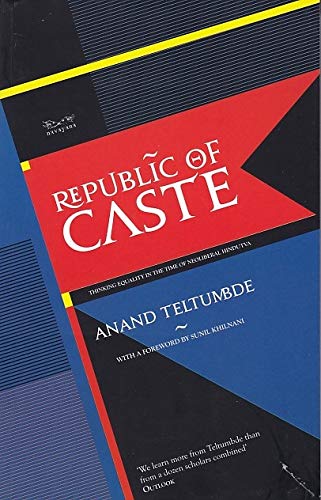Why I picked this book?
Caste and caste system in India is very regressive. It boxes human beings into fixed hierarchal compartments from where it is difficult move up or move out. Most of the people are not aware of the complexities and view it merely in terms of reservations in schools, colleges, and jobs. Beyond that people generally have very little knowledge what caste system is and how it affects the people who are at the bottom of this hierarchal system. So, to get some nuanced details and views I choose to read this book by Anand Teltumbde.
The Book
Republic of Caste – Thinking Equality in the Time of Neoliberal Hindutva is a collection of writings on the various aspects of Dalit issues be it reservation, education system, violence against Dalits, Dalit protests, the problem of branding the tribal people as Naxal. It also critically looks at how the present government is trying to appropriate Dr. Ambedkar to consolidate the Dalit votes in their favour. The analysis of the Swachh Bharat, which the author says is all rhetoric till the caste system is not annihilated. He seeks our attention to the fact that how inequality has increased over the years and is still increasing and how it affects the people at the bottom rung of caste system. The author critically analyzes different viewpoints pertaining to caste and gives the readers a new perspective to look at caste and how it still very much a part of our social structure.
In the very first chapter of the book the author talks about reservations, what general people think about it. The author then provides a detailed account of reservations, how it came into being and did it serve it purpose for which it was meant. The author argues that the reservations did not yield the results as it was supposed to, and it helped the upper caste more than the Dalits.
“Despite Ambedkar’s own disclosure – in a statement to Rajya Sabha on 2 September 1953 – that he was used by the congress as a hack to write the Constitution, which was of no use to anyone, Dalits by and large continue to swear by the Constitution.”
The author talks about how the understanding of caste and class played it role in India. He says, “these two words have divided the working-class movement into two camps – movement oriented towards class struggle and those against caste, each driven by the ideological obsessions of their protagonists through divergent paths that led to eventual marginalization of both.” There is a critical analysis of what does Ambedkar stands for, who are Ambedkarites and what really Ambedkarism means, which everybody in the political spectrum is trying to appropriate. How the political parties, successive governments and their policies focused on the superficial aspects of caste system steering clear away from the root cause – the annihilation of caste.
The author provides a study about the different faction that splintered from the Ambedkar movement and their relevance in the present times. There is a detailed analysis of how the BJP is trying to appropriate Dr. Ambedkar by painting him an admirer of Hindus, an admirer of RSS and the one who opposed to Muslims and communists. This is done through quoting him out of context and sometime plainly on false statements attributed to Dr. Ambedkar. The reasons for BJP and RSS to co-opt Dr. Ambedkar is for electoral purpose and brining the Dalits under the Hindu fold to gain the numbers and achieve their goal of “Hindu Rashtra”. Though this is what Amberkdar wrote in Pakistan or Partition of India in 1945.
“If Hindu Raj does become a fact, it will no doubt, be the greatest calamity for this country. No matter what the Hindus days, Hinduism is a menace to liberty, equality and fraternity. On that account it is incompatible with democracy. Hindu Raj must be prevented at any cost.”
There is an analysis of the Dalit political parties, especially BSP- Bahujan Samajwadi Party. The founder and leader of the party Kasnshi Ram and his ideology, which was assertation of caste rather than annihilation of caste. The rise of Kanshi Ram and BSP politically, however the author questions whether it made any impact to the core issue of the caste system. The author makes a critical analysis of the various political parties and their viewpoint and stand on caste system. His take on various governments on the issues of caste and tribal people and their approach and handling the issues of the tribal people termed or branded as Naxalites, who falls at the lowest rung of the social structure.
All the chapters deal in detail with the subject and provide strong arguments and critique of the generally perceived thoughts and understanding of people about caste, reservation, caste politics and its impact on the people who are affected by it. Also, the role of Constitution, the role of various governments and the policies for Dalits and did they really help in achieving the goal or made it more complex just to have the status-quo? It will answer many of your queries and doubts and leave you with more questions, the prime among them are we even serious about removing caste system?
About the Author
Anand Teltumbde is a civil rights activist and a columnist with the Economic & Political Weekly. Among his many books are Dalits: Past, Present and Future, Mahad: The Making of the First Dalit Revolt and The Persistence of Caste: The Khairlanji Murders and India’s Hidden Apartheid. He teaches at the Goa Institute of Management.
Our Verdict
Informative, intellectually stimulating with sharp and logical arguments, the book is a must read for anyone who needs to understand the caste system and the complexities around it.
